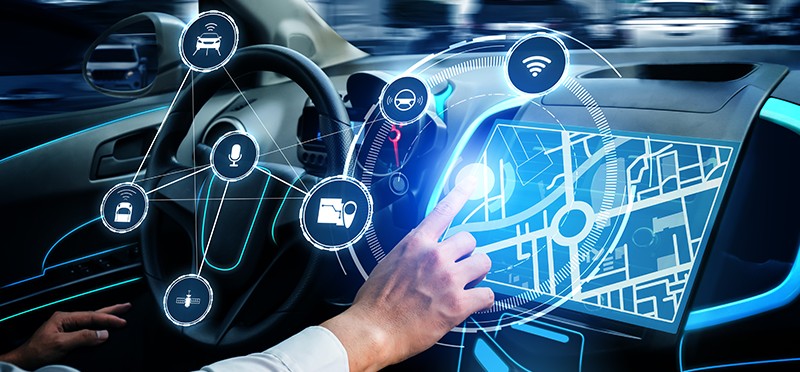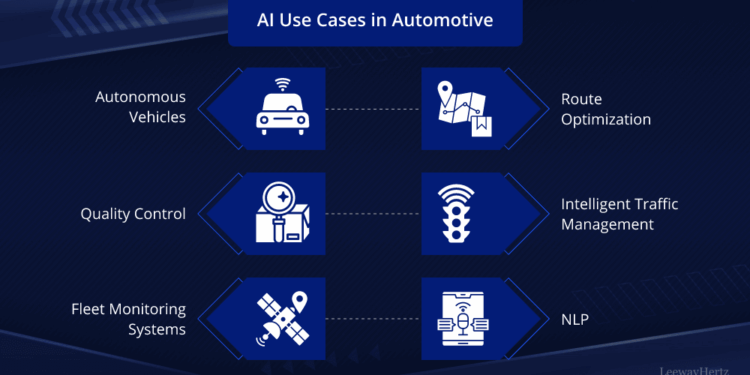Artificial Intelligence (AI) has rapidly advanced and integrated itself into almost every aspect of modern life, revolutionizing industries and making products smarter, faster, and more intuitive. In the automotive sector, AI is playing an increasingly crucial role in enhancing the in-car user experience, elevating safety standards, and optimizing vehicle performance. As vehicles become more connected and automated, AI is transforming the way we interact with our cars, bringing convenience, efficiency, and an unprecedented level of personalization to the driving experience.
This article delves into how AI is reshaping the automotive world, improving in-car experiences, and boosting safety. We’ll explore the latest innovations in AI for cars, its impact on vehicle systems, and what it means for drivers and passengers alike. Additionally, we’ll take a look at the broader implications of AI in the automotive sector, including its potential to shape the future of transportation.
A. The Role of AI in Automotive Technology
AI’s integration into the automotive industry isn’t limited to self-driving cars. It extends to various systems and features that enhance safety, convenience, and overall driving experience. From intuitive infotainment systems to predictive maintenance, AI is present in numerous facets of modern vehicles. Let’s explore how AI is enhancing car technology across different aspects.

A.1. AI-Powered Infotainment Systems
AI is revolutionizing in-car infotainment systems, turning them into intelligent, responsive platforms that cater to the unique needs and preferences of each driver. These systems go beyond simple touchscreens, integrating voice recognition, personalized recommendations, and adaptive interfaces to create a seamless experience.
-
Voice Recognition: AI-driven voice recognition systems, like Amazon’s Alexa and Google Assistant, enable drivers to control in-car functions hands-free. This feature enhances convenience and reduces distractions, as drivers can issue commands such as changing music, making calls, or adjusting climate control without taking their hands off the wheel or eyes off the road.
-
Personalization: AI-powered infotainment systems can learn from user behavior over time and tailor content and suggestions based on preferences. For instance, the system can suggest favorite playlists, routes, or destinations, making the driving experience more enjoyable and customized.
-
Intelligent Navigation: AI plays a critical role in advanced navigation systems. It can analyze real-time traffic data, provide alternative routes, and offer predictive insights based on the driver’s habits, making navigation more efficient and reducing travel times.
A.2. Predictive Maintenance
AI’s ability to process vast amounts of data and identify patterns enables predictive maintenance in vehicles. This technology helps to forecast when a vehicle part is likely to fail or require maintenance before it becomes an issue, potentially preventing breakdowns and enhancing vehicle reliability.
-
Real-time Diagnostics: AI systems can monitor the performance of various vehicle components, such as the engine, battery, and brakes, and alert drivers about any potential issues. This helps in early detection of problems, allowing drivers to address them before they escalate into costly repairs.
-
Cost Savings: Predictive maintenance reduces the need for unexpected repairs, saving drivers money and ensuring the vehicle remains in optimal condition. The system can also suggest when to schedule maintenance, making it easier for owners to keep their cars in good working order.
B. AI in Driver Assistance and Safety Systems
AI is also revolutionizing the safety aspect of driving. Advanced Driver Assistance Systems (ADAS) utilize AI algorithms to enhance vehicle safety, reduce the risk of accidents, and make driving more intuitive. These systems are designed to support the driver, helping them make better decisions and reduce human error, which is a leading cause of traffic accidents.
B.1. Autonomous Driving
One of the most significant applications of AI in the automotive sector is the development of autonomous vehicles. While fully autonomous cars are still in development and face regulatory and technological challenges, AI has already made strides in semi-autonomous driving systems, enabling cars to take over certain tasks like steering, braking, and accelerating.
-
Level 1 and 2 Automation: AI-powered systems such as adaptive cruise control and lane-keeping assistance already make driving less demanding. These features allow the vehicle to assist with speed regulation and ensure that the car stays within its lane, all while the driver maintains control.
-
Level 3 and Beyond: Future advancements in AI will push toward higher levels of autonomy, with cars that are capable of driving themselves in more complex environments. AI systems will be able to analyze road conditions, predict potential hazards, and make real-time decisions, enabling a safer and more efficient driving experience.
B.2. Collision Avoidance
AI also plays a crucial role in collision avoidance systems. These systems use AI algorithms to detect potential obstacles, vehicles, or pedestrians in the car’s path, even when they might be difficult to see. Using sensors like cameras, radar, and lidar, AI can calculate the likelihood of a collision and take action if necessary.
-
Automatic Braking: In case of an imminent collision, AI-driven systems can apply the brakes automatically to avoid an accident. This is especially beneficial in situations where a driver may be distracted or unable to react quickly enough.
-
Pedestrian Detection: AI systems can identify pedestrians or cyclists in the vehicle’s path, issuing alerts or activating the braking system if the driver does not respond in time.
B.3. Lane Departure Warning
Another safety feature powered by AI is lane departure warning (LDW), which alerts the driver when the vehicle unintentionally drifts out of its lane without signaling. This system helps prevent accidents caused by driver distraction or fatigue, providing an added layer of security.
-
Lane-Keeping Assist: AI can also provide lane-keeping assist, where the car gently steers itself back into the lane if it begins to veer off track. This is particularly useful on long road trips or in heavy traffic when driver attention may lapse.
C. In-Car Experience Beyond Driving

AI’s influence in vehicles is not limited to the safety and performance aspects of driving; it also significantly impacts the comfort and convenience of the in-car experience for passengers. Whether it’s through entertainment or personalized climate settings, AI is enhancing every aspect of how we interact with our cars.
C.1. Intelligent Climate Control
AI-powered climate control systems learn and adapt to the driver’s and passengers’ preferences over time, creating a more comfortable cabin environment. These systems can automatically adjust the temperature based on real-time conditions, such as outside weather and in-car occupancy.
-
Personalized Temperature Zones: AI can create personalized temperature settings for different areas of the vehicle, ensuring everyone in the car enjoys their ideal level of comfort.
-
Adaptive Airflow: In addition to controlling temperature, AI can regulate airflow to ensure the cabin maintains optimal air quality. It can detect when more ventilation is needed or when certain zones need to be heated or cooled more.
C.2. AI-Driven Entertainment
AI is also enhancing in-car entertainment systems by offering personalized content based on individual preferences. From music recommendations to personalized news or podcast suggestions, AI makes sure the passengers’ entertainment needs are met seamlessly.
-
Music and Media Suggestions: AI can analyze listening habits and suggest music, podcasts, or audiobooks based on the driver’s tastes and listening history.
-
Smart Connectivity: Voice-controlled assistants like Siri, Alexa, or Google Assistant can be integrated into the car’s infotainment system, enabling passengers to control entertainment options hands-free, such as adjusting volume or skipping tracks.
D. Challenges and Ethical Considerations
While the integration of AI in cars presents numerous benefits, it also raises concerns about privacy, cybersecurity, and ethical implications. With cars collecting and processing massive amounts of data from their users, questions about data security and ownership become critical.
D.1. Privacy Concerns
The use of AI in vehicles involves the collection of vast amounts of data, including driving behavior, location history, and even personal preferences. This data can be valuable for improving the in-car experience, but it also raises significant privacy concerns.
-
Data Protection: Automakers must ensure that user data is adequately protected from breaches and misuse. This includes ensuring secure data storage and transmission, as well as giving users control over their personal information.
-
Transparency: Manufacturers must be transparent about what data they collect and how it is used, allowing drivers to make informed decisions about their privacy.
D.2. Ethical Considerations in Autonomous Driving
As AI continues to advance in autonomous driving, ethical questions arise about how self-driving cars should make decisions in critical situations. For example, if an unavoidable accident occurs, should the car prioritize the safety of its passengers or minimize harm to others? These “trolley problems” are complex ethical dilemmas that engineers and regulators must address as AI progresses.















